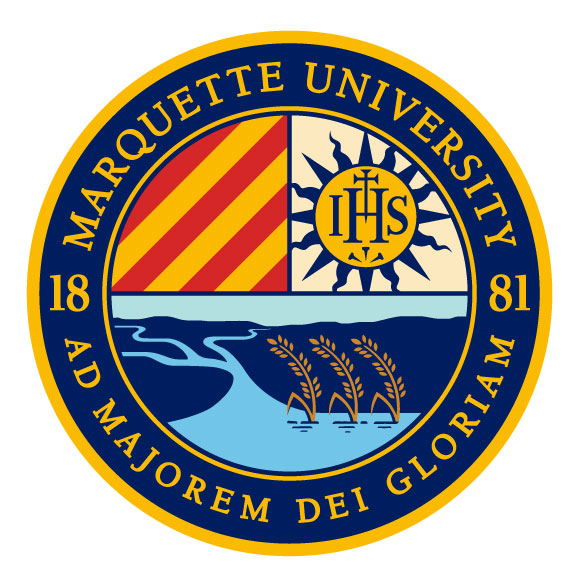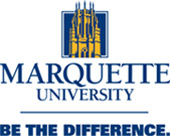Marquette logo, seal and monogram styleguides
To request a Marquette logo, please complete our logo request form.

The Marquette University Board of Trustees approved this updated Marquette University seal in 2022. It is reserved for use on approved official and presidential documents and events.
The outer ring features the name of the university, its founding year (1881) and the Jesuit motto, Ad majorem Dei gloriam, “For the greater glory of God.” In this way, the outer circle frames the seal with who we are, how long Marquette University has existed and the university’s purpose.
The seal’s interior is divided into two upper sectors composing one half of the circle; one lower sector makes up the other half.
The upper half honors Marquette’s Catholic, Jesuit tradition and values. The upper left sector features gold and red diagonal bands to honor the seven heroic brothers from the maternal side of St. Ignatius of Loyola's (1491–1556) family. The upper right sector houses the monogram of the Society of Jesus, a Christogram that forms an abbreviation for the name of Jesus Christ in Greek — a longstanding symbol for the Jesuits. In the monogram, a cross rises from the H; below it, three nails symbolize the Crucifixion. Surrounding the monogram is a sunburst. The placement on the upper right side symbolizes a rising sun.
The lower half acknowledges Marquette’s location among the lands and waterways of the area’s Indigenous nations. The landscape depicted in this space is devoted to symbols that reflect and honor the ongoing presence and spirit of these Indigenous nations. The three rivers represent the Milwaukee, Menomonee and Kinnickinnic rivers and recognize the significance of water to our location and history. The water and lands more largely connected Indigenous guides to the university’s namesake, Rev. Jacques Marquette, S.J. (1637–1675).
The representation of wild rice recognizes the sustaining food source that once abundantly grew in the flourishing waters and was mindfully harvested by Indigenous peoples. The three stalks of wild rice emerging from the waters are a potent reminder of the historic presence of Potawatomi, Menominee and Ho-Chunk nations, who along with other tribal nations, continue to vibrantly reside in the area.
The university seal reflects Marquette’s history, tradition and Catholic, Jesuit mission, and honors the role of the Indigenous nations that guided Father Marquette on his journey.
Marquette University thanks Milwaukee-based Oneida artist Kristelle M. Ulrich for her creative design contributions to the university seal.
Why was the university seal updated?
In 2020, President Lovell formed a committee to update the university seal to better reflect Marquette’s history, tradition and Catholic, Jesuit mission, and more accurately reflect the role of the Indigenous nations that guided Father Marquette on his journey. As an institution, we have been called to reflect on our symbols, and it became clear that Marquette needs a seal that aligns with our mission, vision and guiding values and also reaffirms our Statement on Human Dignity and Diversity. We sought to create a seal with a sense of history, purpose, pride, and healing that supports the efforts of institutional change, progress and reconciliation. The updated university seal reflects who we are and what we stand for.
Who was involved in the process to update the university seal?
The committee to update the university seal was formed by President Lovell with the support of the Board of Trustees. It was chaired by Rana Altenburg, associate vice president of public affairs, and included members representing:
Milwaukee-based Oneida artist Kristelle M. Ulrich contributed to the creative design of the updated university seal.
The Board of Trustees approved the updated seal at their February 2022 meeting.
How were Jesuits involved in the decision or the updated design process?
The Jesuit community played an integral role in updating the seal. There are several Jesuits on the university’s Board of Trustees who were involved in the decision-making process. Additionally, there were Marquette Jesuits on the committee involved with updating the seal.
What do the symbols on the seal mean?
Why is the image of Father Marquette and a Native American no longer part of the university seal?
Rather than depicting individual people, the updated seal incorporates symbols and images that represent Marquette’s Catholic, Jesuit tradition and values. It also includes shared symbols that represent the presence of three Indigenous peoples — the Menominee, Potawatomi and Ho-Chunk — who called Milwaukee home long before any colonial settlers.
The image of Father Marquette and a Native American in the previous university seal was based on the painting “Father Marquette and the Indians” (1869) by Wilhelm Alfred Lamprecht. The way the painting was cropped within the previous university seal gave the impression that Father Marquette was giving directions to his Native American guide when, in fact, the full painting shows he was receiving direction from Native peoples on the shore.
Why couldn’t the Father Marquette painting be cropped differently to be more inclusive?
Lamprecht’s artwork was painted approximately 200 years after Father Marquette’s travels in the Milwaukee area and is not an accurate depiction of historical events. While the full painting is more historically accurate than the cropped image, it is still problematic in how it uses a composite image of a Native American when there were multiple tribes that Father Marquette encountered on his journey. Showing only one Native person suggests homogeneity and is not an accurate representation of the diversity of those who were native to the land on which Marquette University is located.
Why was a different motto selected for the new university seal?
The updated seal seeks to better reflect Marquette’s history, tradition and Catholic, Jesuit mission. It features the Jesuit motto, Ad majorem Dei gloriam, which translates to “For the greater glory of God.” It is often abbreviated as AMDG and can be found throughout Jesuit institutions worldwide, particularly on building cornerstones, including many at Marquette.
Will we still use “Be The Difference” as the university tagline?
Yes. It is important to recognize that the university seal differs from the university logo and athletics monogram. Marquette’s official seal is only used on approved official and presidential documents and at presidential events.
When will the previous university seals utilized on our physical campus and on marquette.edu be updated?
The university is now in the process of updating the seal around campus, with plans to incorporate the new seal in some of its most prominent places, including but not limited to the Wisconsin Avenue archway outside the Alumni Memorial Union and the nine stone portals in the Wisconsin Avenue median.
Some seals around campus will not be updated; in those instances, educational plaques will accompany the old seal to provide historical context.

The Marquette logo, revised in 1995, comprises the words "Marquette University" and a graphic representation of the Marquette Hall tower.
Be The Difference.
In September 2002, Marquette adopted the tagline "Be The Difference." The university aims to form women and men for others and help students and the entire Marquette community become the kinds of leaders who will make important contributions — who will Be The Difference in their communities.

The athletics monogram was designed for the express use of the Intercollegiate Athletics and Recreational Sports. The interlocking "M" and "U" depict the teamwork that is a hallmark of Marquette athletics, and the classic styling of the letters indicates the long history of athletics excellence at the university. And, most important, the glowing highlighted letters portray the promise of a shining future for our teams and fans.